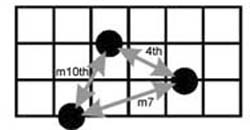« Top Six Tips & Tricks of 2014 |
Main
| Zak Borden; Circle of 5ths Part 2 »
 January 8, 2015 | Best of JM: Chord Economy January 8, 2015 | Best of JM: Chord Economy
Enjoy the popular archive material below.
From March 8, 2012 | Chord Economy
It's easy to go through life just acquiring chords. Find a new fingering in context and slap it on to your personal chord vocabulary. Years of playing experience, you'll accumulate a healthy arsenal of chords, but sometimes knowing what's under the hood can put the fretboard journey into hyperdrive.
We've talked about this before in expanding the library, exploring what we call "chord economics." The fact we only have four voices with our eight strings limits how many notes of a complex extended chord we can express. The good news is despite the six note complexity in a Maj13 chord, we don't have to cut the proverbial baby in half. Knowing which tones are important, which are superfluous, we can walk proudly into a jam session and still speak the jazz dialect fluently. You just have to know some of the chemistry of the chord.
CHORD VOICE PRIORITIES
Tonality: (Someone else's job!)
Third: Majorness/Minorness
Fifth: (always implied except when diminished or augmented)
Seventh: Stability resolved or "to be" resolved)
Color: (Extensions)
On the above list, if you're playing in a group, the tonality of the chord (the root) is generally covered by the bass (or the lowest note of an instrument lower than the mandolin), so you can chalk that one off. The 3rd is important because of its disclosure of majorness/minorness. The 5th is implied (unless your playing a b5 or Augmented chord), so leave it out. The 7th is important because of its stability, the "resolve me" factor. The last note(s), the 9th or 13th are your color tones. They aren't necessary but they are the delicious frosting on the cake.
In other words, you really only need three, 3rd, 7th, and color extension. Nothing wrong with having a root in there, and if you're playing solo, you want it injected as often as possible. Now you can see the fluidity that remains in four voices. Add the dimension of time, the aural permanence for the ear playing several inversions of the same chord before it changes in the music, and we really strut our harmonic prowess.
Check out some of our other articles on the nature of chord economics.

Further
Three's company. 3-note chord
Axis of the 3rd & 7ths
Mandolin Chord Economics
Need a chord?
New ways to comp with V7 chords
Posted by Ted at January 8, 2015 9:25 PM

Disclaimer: In the 'Information Age' of the 21st Century,
any fool with a computer, a modem, and an idea can
become a self-professed 'expert." This site does not
come equipped with 'discernment.'
|



